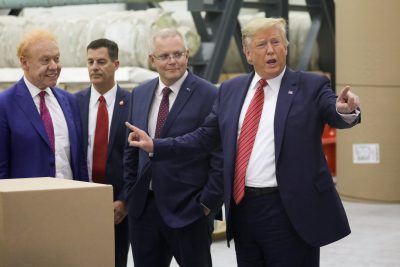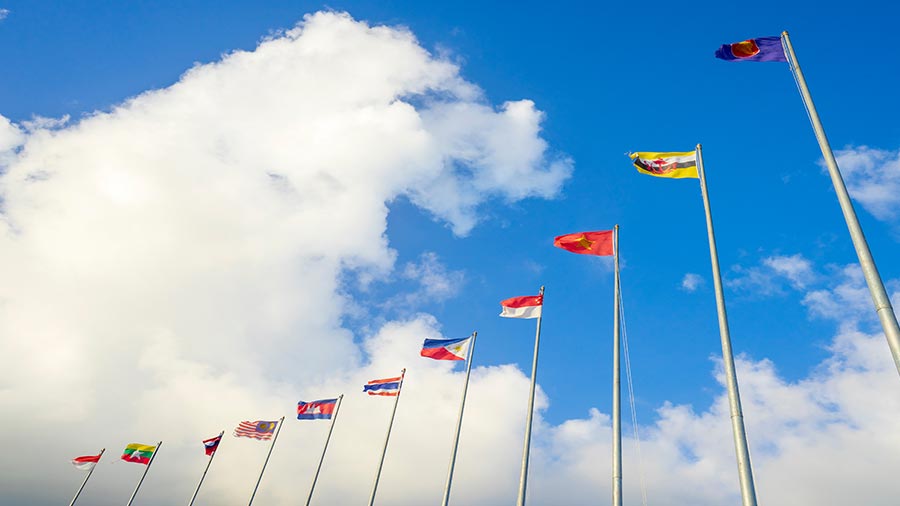China
Integrating Australia’s security and economic policy cultures

Author: Brendan Sargeant, ANU
The debate in Australia about China is intensifying and some of the optimism of a decade ago has dissipated. This is in part a result of Chinese actions, particularly concerning security, but also a result of shifts in US trade and economic policy towards China. Despite plenty of warning that China would become a major strategic and policy challenge, Australia is struggling to develop a framework that integrates different strands of policy to guide decision-making related to China in coming decades.
Policy is built on ideas about the world and how it works. A feature of the Australian policy environment is the separation of policy into different domains. In particular, there is a strong separation between economic policy and security policy.
One example is Australian policy towards the United States. Both Coalition and Labor governments have avoided linking the security and economic relationships, particularly in the areas of trade and investment. They have argued that the security relationship should be understood and managed separately from the trade relationship and that neither should be made hostage to the other. With China policy, both governments have also tried to separate security policy from economic policy.
The changing strategic order makes this approach unsustainable, not least because China generally does not operate this way. Much of the debate on China policy is concerned with trying to strike the right balance between Australia’s economic and security interests. Almost every issue concerning China brings these competing imperatives into play. This has been amplified by major shifts in US policy towards China and an increased willingness by the United States to use economic levers to challenge China.
In consequence, the coming decades are likely to witness increasing economic nationalism, greater coercion using economic instruments and reduced confidence in institutions that have underpinned the rules-based international order. In this environment there is a need to develop a strategic policy framework that integrates economics and security.
This is not only an intellectual challenge. It is also an institutional one. The structure of policymaking in Australia does not encourage a conceptual framework that integrates these imperatives. There is little focus on economic considerations from Defence and the Treasury’s contribution to the security debate is negligible. Coordination from the centre is weak, even if the Department of Foreign Affairs and Trade has worked to bridge the divide. The 2017 Foreign Policy White Paper introduced some different ways of thinking about Australia’s strategic environment and the policy instruments available, but this has not yet resulted in significant change in the policymaking culture.
Perhaps the challenge runs deeper. Security and economic policy cultures embody profoundly different ways of thinking about the world. They look at the same environment and see different patterns and forces at play. They may not necessarily agree on what the strategic problems are or their significance and order of importance.
The exercise of power through the use of economic instruments is quite different from the exercise of power using coercive instruments of the state, such as armed forces. Decisions in either sphere will engage different interest groups. Time as both a strategic reality and a resource is viewed differently. Both policy cultures tend towards totalising frameworks, with the result that hubris can lead them to believe that they have the complete solution to almost all problems.
The tools of both economic and security policy are a means to an end. States will use the instruments available to them to seek advantage and will integrate these different instruments to do so — subject to some constraints. China exercises coercive power through the use of economic levers, as well as more traditional means of coercion such as its claims to disputed territories and militarisation in the South China Sea. The United States is using tariff policy to achieve strategic ends in its relations with countries around the world, particularly China.
Australia was able to sustain the separation of these domains because the rules-based order allowed it to. Policy development took place in a strategic order that was stable where either the rules governing that order were generally agreed upon or guaranteed by allied military power. The rules-based order allowed the establishment of institutions through which economic policy could be conducted….
Business
Gordonstoun Severs Connections with Business Led by Individual Accused of Espionage for China

Gordonstoun school severed ties with Hampton Group over espionage allegations against chairman Yang Tengbo. He denies involvement and claims to be a victim of political tensions between the UK and China.
Allegations Lead to School’s Decision
Gordonstoun School in Moray has cut ties with Hampton Group International after serious allegations surfaced regarding its chairman, Yang Tengbo, who is accused of being a spy for the Chinese government. Known by the alias "H6," Mr. Tengbo was involved in a deal that aimed to establish five new schools in China affiliated with Gordonstoun. However, the recent allegations compelled the school to terminate their agreement.
Public Denial and Legal Action
In response to the spying claims, Mr. Tengbo publicly revealed his identity, asserting that he has committed no wrongdoing. A close associate of Prince Andrew and a former Gordonstoun student himself, Mr. Tengbo has strenuously denied the accusations, stating that he is a target of the escalating tensions between the UK and China. He has claimed that his mistreatment is politically motivated.
Immigration Challenges and Legal Responses
Yang Tengbo, also known as Chris Yang, has faced additional challenges regarding his immigration status in the UK. After losing an appeal against a ban enacted last year, he reiterated his innocence, condemning media speculation while emphasizing his commitment to clear his name. Gordonstoun, on its part, stated its inability to divulge further details due to legal constraints.
Source : Gordonstoun cuts ties with business chaired by man accused of spying for China
Business
China Dismantles Prominent Uyghur Business Landmark in Xinjiang – Shia Waves

The Chinese government demolished the Rebiya Kadeer Trade Center in Xinjiang, affecting Uyghur culture and commerce, prompting criticism from activists amid concerns over cultural erasure and human rights violations.
Demolition of a Cultural Landmark
The Chinese government recently demolished the Rebiya Kadeer Trade Center in Urumqi, Xinjiang, a vital hub for Uyghur culture and commerce, as reported by VOA. This center, once inhabited by more than 800 predominantly Uyghur-owned businesses, has been deserted since 2009. Authorities forcibly ordered local business owners to vacate the premises before proceeding with the demolition, which took place without any public notice.
Condemnation from Activists
Uyghur rights activists have condemned this demolition, perceiving it as part of China’s broader strategy to undermine Uyghur identity and heritage. The event has sparked heightened international concern regarding China’s policies in Xinjiang, which have been characterized by allegations of mass detentions and cultural suppression, prompting claims of crimes against humanity.
Rebiya Kadeer’s Response
Rebiya Kadeer, the center’s namesake and a notable Uyghur rights advocate, criticized the demolition as a deliberate attempt to erase her legacy. Kadeer, who has been living in exile in the U.S. since her release from imprisonment in 2005, continues to advocate for Uyghur rights. She has expressed that her family members have suffered persecution due to her activism, while the Chinese government has yet to comment on the legal ramifications of the demolition.
Source : China Demolishes Uyghur Business Landmark in Xinjiang – Shia Waves
China
China Expands Nationwide Private Pension Scheme After Two-Year Pilot Program

China’s private pension scheme, previously piloted in 36 cities, will roll out nationwide on December 15, 2024, enabling workers to open tax-deferred accounts. The initiative aims to enhance retirement savings, address aging population challenges, and stimulate financial sector growth.
After a two-year pilot program, China has officially expanded its private pension scheme nationwide. Starting December 15, 2024, workers covered by urban employee basic pension insurance or urban-rural resident basic pension insurance across the country can participate in this supplementary pension scheme. This nationwide rollout represents a significant milestone in China’s efforts to build a comprehensive pension system, addressing the challenges of a rapidly aging population.
On December 12, 2024, the Ministry of Human Resources and Social Security, together with four other departments including the Ministry of Finance, the State Taxation Administration, the Financial Regulatory Administration, and the China Securities Regulatory Commission, announced the nationwide implementation of China’s private pension scheme effective December 15, 2024. The initiative extends eligibility to all workers enrolled in urban employee basic pension insurance or urban-rural resident basic pension insurance.
A notable development is the expansion of tax incentives for private pensions, previously limited to pilot cities, to a national scale. Participants can now enjoy these benefits across China, with government agencies collaborating to ensure seamless implementation and to encourage broad participation through these enhanced incentives.
China first introduced its private pension scheme in November 2022 as a pilot program covering 36 cities and regions, including major hubs like Beijing, Shanghai, Guangzhou, Xi’an, and Chengdu. Under the program, individuals were allowed to open tax-deferred private pension accounts, contributing up to RMB 12,000 (approximately $1,654) annually to invest in a range of retirement products such as bank deposits, mutual funds, commercial pension insurance, and wealth management products.
Read more about China’s private pension pilot program launched two years ago: China Officially Launches New Private Pension Scheme – Who Can Take Part?
The nationwide implementation underscores the Chinese government’s commitment to addressing demographic challenges and promoting economic resilience. By providing tax advantages and expanding access, the scheme aims to incentivize long-term savings and foster greater participation in personal retirement planning.
The reform is expected to catalyze growth in China’s financial and insurance sectors while offering individuals a reliable mechanism to enhance their retirement security.
| This article was first published by China Briefing , which is produced by Dezan Shira & Associates. The firm assists foreign investors throughout Asia from offices across the world, including in in China, Hong Kong, Vietnam, Singapore, and India . Readers may write to info@dezshira.com for more support. |
Read the rest of the original article.






